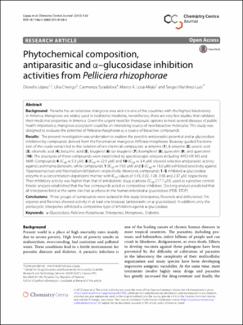| dc.contributor.author | López, Dioxelis | |
| dc.contributor.author | Cherigo, Lilia | |
| dc.contributor.author | Spadafora, Carmenza | |
| dc.contributor.author | Loza‑Mejía, Marco A. | |
| dc.contributor.author | Martínez, Luis Sergio | |
| dc.date.accessioned | 2020-06-24T16:24:01Z | |
| dc.date.available | 2020-06-24T16:24:01Z | |
| dc.date.issued | 2015-09-28 | |
| dc.identifier.other | DOI 10.1186/s13065-015-0130-3 | |
| dc.identifier.uri | http://repositorio-indicasat.org.pa/handle/123456789/106 | |
| dc.description | Panama has an extensive mangrove area and it is one of the countries with the highest biodiversity in America. Mangroves are widely used in traditional medicine, nevertheless, there are very few studies that validates their medicinal properties in America. Given the urgent need for therapeutic options to treat several diseases of public health importance, mangrove ecosystem could be an interesting source of new bioactive molecules. This study was designed to evaluate the potential of Pelliciera rhizophorae as a source of bioactive compounds. Results: The present investigation was undertaken to explore the possible antiparasitic potential and α-glucosidase inhibition by compounds derived from the Panamanian mangrove Pelliciera rhizophorae. Bioassay-guided fractiona‑ tion of the crude extract led to the isolation of ten chemical compounds: α-amyrine (1), β-amyrine (2), ursolic acid (3), oleanolic acid (4), betulinic acid (5), brugierol (6) iso-brugierol (7), kaempferol (8), quercetin (9), and quercetrin (10). The structures of these compounds were established by spectroscopic analyses including APCI-HR-MS and NMR. Compounds 4 (IC50 = 5.3 µM), 8 (IC50 = 22.9 µM) and 10 (IC50 = 3.4 µM) showed selective antiparasitic activity against Leishmania donovani, while compounds 1 (IC50 = 19.0 µM) and 5 (IC50 = 18.0 µM) exhibited selectivity against Tripanosoma cruzi and Plasmodium falciparum, respectively. Moreover, compounds 1–5 inhibited α-glucosidase enzyme in a concentration-dependent manner with IC50 values of 1.45, 0.02, 1.08, 0.98 and 2.37 µM, respectively. Their inhibitory activity was higher than that of antidiabetic drug acarbose (IC50 217.7 µM), used as a positive control. Kinetic analysis established that the five compounds acted as competitive inhibitors. Docking analysis predicted that all triterpenes bind at the same site that acarbose in the human intestinal α-glucosidase (PDB: 3TOP). | en_US |
| dc.description.abstract | Panama has an extensive mangrove area and it is one of the countries with the highest biodiversity in America. Mangroves are widely used in traditional medicine, nevertheless, there are very few studies that validates their medicinal properties in America. Given the urgent need for therapeutic options to treat several diseases of public health importance, mangrove ecosystem could be an interesting source of new bioactive molecules. This study was designed to evaluate the potential of Pelliciera rhizophorae as a source of bioactive compounds. Results: The present investigation was undertaken to explore the possible antiparasitic potential and α-glucosidase inhibition by compounds derived from the Panamanian mangrove Pelliciera rhizophorae. Bioassay-guided fractiona‑ tion of the crude extract led to the isolation of ten chemical compounds: α-amyrine (1), β-amyrine (2), ursolic acid (3), oleanolic acid (4), betulinic acid (5), brugierol (6) iso-brugierol (7), kaempferol (8), quercetin (9), and quercetrin (10). The structures of these compounds were established by spectroscopic analyses including APCI-HR-MS and NMR. Compounds 4 (IC50 = 5.3 µM), 8 (IC50 = 22.9 µM) and 10 (IC50 = 3.4 µM) showed selective antiparasitic activity against Leishmania donovani, while compounds 1 (IC50 = 19.0 µM) and 5 (IC50 = 18.0 µM) exhibited selectivity against Tripanosoma cruzi and Plasmodium falciparum, respectively. Moreover, compounds 1–5 inhibited α-glucosidase enzyme in a concentration-dependent manner with IC50 values of 1.45, 0.02, 1.08, 0.98 and 2.37 µM, respectively. Their inhibitory activity was higher than that of antidiabetic drug acarbose (IC50 217.7 µM), used as a positive control. Kinetic analysis established that the five compounds acted as competitive inhibitors. Docking analysis predicted that all triterpenes bind at the same site that acarbose in the human intestinal α-glucosidase (PDB: 3TOP). | en_US |
| dc.format | application/pdf | |
| dc.language.iso | eng | en_US |
| dc.rights | Info:eu-repo/semantics/openAccess | |
| dc.rights | https://creativecommons.org/licenses/by/4.0/ | |
| dc.subject | α-α-Glucosidase | en_US |
| dc.subject | Pelliciera rhizophorae | en_US |
| dc.subject | Triterpenes | en_US |
| dc.subject | Mangroves | en_US |
| dc.subject | Diabetes | en_US |
| dc.title | Phytochemical composition, antiparasitic and α–glucosidase inhibition activities from Pelliciera rhizophorae | en_US |
| dc.type | info:eu-repo/semantics/article | en_US |
| dc.type | Info:eu-repo/semantics/publishedversion | |

